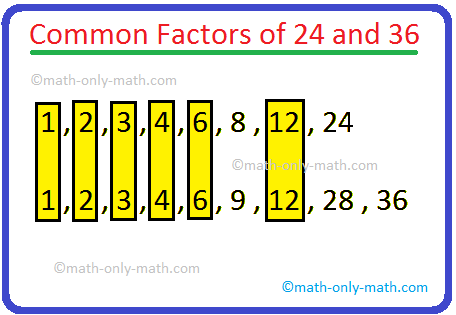Subscribe to our ▶️ YouTube channel 🔴 for the latest videos, updates, and tips.
Common Factors of Two or More Numbers
Common factors of two or more numbers are a number which divides each of the given numbers exactly.
Let us find all the factors of number 24 and 36
Factors of 24 are 1, 2, 3, 4, 6, 8, 12 and 24
Factors of 36 are 1, 2, 3, 4, 6, 9, 12, 18 and 36
The common factors of above are shown below.
The factors common to two or more numbers are known as common factors, in the example given above, 12 is the highest common factor of 24 and 36.
For examples
1. Find the common factor of 6 and 8.
Factor of 6 = 1, 2, 3 and 6.
Factor of 8 = 1, 2, 4 and 8.
Therefore, common factors of 6 and 8 = 1 and 2.
[It can easily be shown that each common factor (1 and 2) divides the given numbers 6 and 8 exactly].
2. Find the common factor of 8 and 12.
Factor of 8 = 1, 2, 4 and 8.
Factor of 12 = 1, 2, 3, 4, 6 and 12.
Therefore, common factors of 8 and 12 = 1, 2 and 4.
3. Find the common factor of 10 and 15.
Factor of 10 = 1, 2, 5 and 10.
Factor of 15 = 1, 3, 5 and 15.
Therefore, common factors of 10 and 15 = 1 and 5.
4. Find the common factor of 14 and 21.
Factor of 14 = 1, 2, 7 and 14.
Factor of 21 = 1, 3, 7 and 21.
Therefore, common factors of 14 and 21 = 1 and 7.
5. How to find the common factors of 4 and 18?
Solution:
The factors of 4 are 1, 2 and 4.
The factors of 18 are 1, 2, 3, 6, 9 and 18.
Thus, the common factors of 4 and 18 are 1 and 2.
5. How to find the common factors of three numbers 15, 25 and 30?
Solution:
The factors of 15 are 1, 3, 5, and 15.
The factors of 25 are 1, 5, and 25.
The factors of 30 are 1, 2, 3, 5, 6, 10, 15, and 30.
Thus, common factors of 15, 25 and 30 are 1 and 5.
Worksheet on Common Factors of Two Numbers:
I. Find all the common factors of
(i) 8 and 12
(ii) 10 and 28
(iii) 12 and 24
(iv) 21 and 49
(v) 20 and 50
(vi) 17 and 51
(vii) 20 and 25
(viii) 24 and 48
(ix) 16 and 24
Answer:
I. (i) 1, 2, 4
(ii) 1, 2, 4
(iii) 1, 2, 3, 4, 6, 12
(iv) 1, 7
(v) 1, 2, 10, 5.
(vi) 1, 17
(vii) 1, 5
(viii) 1, 2, 3, 4, 6, 8, 12, 24
(ix) 1, 2, 4, 8
2. Find the common factors of:
(i) 35 and 50
(ii) 50 and 120
(iii) 4, 8 and 12
(iv) 6, 12 and 36.
Answer:
2. (i) 1 and 5
(ii) 1, 2, 5 and 10
(iii) 1, 2 and 4.
(iv) 1, 2, 3 and 6.
● Factors.
● Highest Common Factor (H.C.F).
● Examples on Highest Common Factor (H.C.F).
● Greatest Common Factor (G.C.F).
● Examples of Greatest Common Factor (G.C.F).
● To find Highest Common Factor by using Prime Factorization Method.
● Examples to find Highest Common Factor by using Prime Factorization Method.
● To find Highest Common Factor by using Division Method.
● Examples to find Highest Common Factor of two numbers by using Division Method.
● To find the Highest Common Factor of three numbers by using Division Method.
From Common Factors of Two or More Numbers to HOME PAGE
Didn't find what you were looking for? Or want to know more information about Math Only Math. Use this Google Search to find what you need.



New! Comments
Have your say about what you just read! Leave me a comment in the box below. Ask a Question or Answer a Question.